

Reduce Your Stress By Normalizing Change. Personal Change Readiness There’s a lot of talk about resistance to change.

The number one question I am asked about managing change is: How do we manage the resistance to change? My answer is, build readiness and you won’t have to manage resistance. Where there is readiness, resistance can’t exist. That’s why I advocate for leaders to help people feel prepared, capable, and supported to move toward something new and different. Change vs. Change Management. Change and change management can seem interchangeable in organizations, but there are significant and important differences between the two.
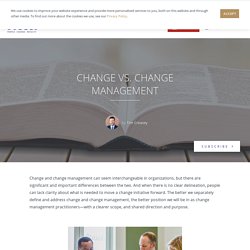
Tilting at windmills. Les quatre conditions pour qu’un changement s’opère. Chroniques d’experts Stratégie Le 17/02/2021.

Bravery and change. Bravery is an outcome, not an input.
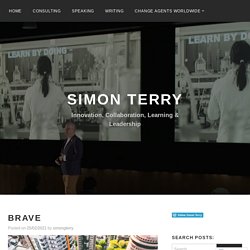
The internet is full of exhortations to be brave. Thoughtleaders love to tell us to be brave, rock boats and take risks. It’s one of those simple exhortations that’s heroic and nonspecific enough to sound motivational and yet inoffensive. Most change agents understand bravery differently. They didn’t set out to be brave. People who invite you to rock the boat do so from the shore.— Simon Terry (@simongterry) February 18, 2021 Bravery comes when the push back hits. Flourishing During Change: An Alternative to Fight or Flight. While in Switzerland I willingly allowed another person to walk me off a cliff.
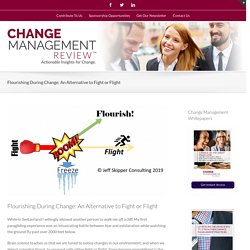
My first paragliding experience was an intoxicating battle between fear and exhilaration while watching the ground fly past over 2000 feet below. Brain science teaches us that we are tuned to notice changes in our environment, and when we detect potential threat, to respond with either fight or flight. Some become immobilized in the face of a threat, giving us a third and even more depressing option: freeze. A prominent technology CEO in Toronto was recently quoted in a headline saying, “Most people don’t like change.”
Indeed, if you listen to the news, we have a lot to fear as the pace of change continues to increase. Uh, no. LinkedIn by Jason Little. 3 astonishing paradoxes that threaten workplace change. In these uncertain times, many of us are looking forward to a dose of normality; for things to go back to how they were before COVID-19 – whether that’s a trip to the movies, a worry-free meal out or a holiday abroad.

But as the pandemic has worn on, it’s become clear that some things are never going to return to how they were. In particular, the way we work has changed indelibly. Thanks to the pandemic, some job roles will disappear and others will emerge. Working from home will become business as usual, at least for some of the time, and workers will rely on cloud-based digital tools far more than in the past.
Change will be profound and lasting. But this is a task that many firms may find easier said than done. 1. LinkedIn by David Williams. Human Centric Reinvention and Transformation: Why it is not as difficult (or as easy) as you may think. 2020 in Reflection: An Extraordinary Year of Change. The changes we all endured this year impacted everything we do as organizations, as change practitioners, and as human beings.
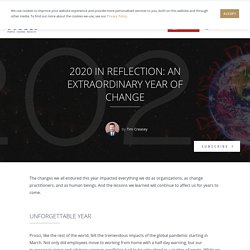
And the lessons we learned will continue to affect us for years to come. Unforgettable Year Prosci, like the rest of the world, felt the tremendous impacts of the global pandemic starting in March. Not only did employees move to working from home with a half-day warning, but our in-person training and advisory services portfolios had to be virtualized in a matter of weeks. Four Organizational Change Myths You Need To Know. The landscape of organizational change and change management has shifted drastically since I started working in the area over 20 years ago.

There was a time when the words change management would cause leaders to leave the room. Now it has become embedded in most leaders’ vocabulary. Change Management: The Change Lifecycle (APMG Change Management) Paradoxical Change and Getting Unstuck. Finding Your Way on the Change Journey. “The course of true change never did run smooth.”William Shakespeare, probably As a change agency, it’s no surprise that the leaders we work with are raring to go when it comes to implementing change.
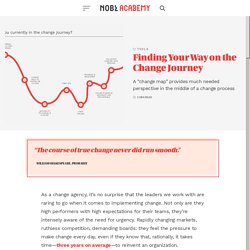
Not only are they high performers with high expectations for their teams, they’re intensely aware of the need for urgency. Rapidly changing markets, ruthless competition, demanding boards: they feel the pressure to make change every day, even if they know that, rationally, it takes time—three years on average—to reinvent an organization. So when we first start on the change journey, the promise of a better future is invigorating. It’s easy enough to imagine a clear strategy that allows teams to effectively prioritize projects; a culture that allows for clearly defined roles and a spirit of collaboration; a workplace where flexible hours and remote policies are the norm.
But then you start implementing changes, and reality sets in. It provides perspective. Le chemin nous semble parfois bien compliqué ou effrayant... Change: homeostasis or translibrium? The Power to Change. If you could have any superpower, what would it be?
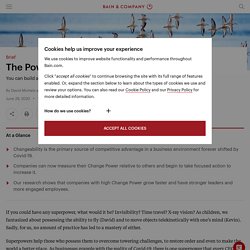
Invisibility? Time travel? X-ray vision? As children, we fantasized about possessing the ability to fly (David) and to move objects telekinetically with one’s mind (Kevin). Sadly, for us, no amount of practice has led to a mastery of either. Three dimensions of change (2012) by Marcelo Manucci. Where Change Starts. Change is Scary, Change Enablement Isn’t. LinkedIn by Tim Creasey. The Age of Change: If We Need Something We've Never Had, We Must Do Something We've Never Done (10 October 2020) by Alessia Tiberi. Is it useful to label change as positive or negative? You may have been asked to rate change into either a positive or negative change to classify initiatives and thereby use the classification to aid change implementation. After all, we all know of initiatives that nearly everyone sees as negative and other initiatives where it’s going to make people’s lives easier, and therefore viewed as mostly positive. So, is it useful to classify every initiative as either positive or negative?
Let’s examine this closely. What is the usefulness of classifying change into either positive or negative? Some managers believe that if we are able to classify change as either positive or negative then we are able to focus on those changes that are perceived as negative since they may require significant managerial effort to drive through the change. Negative changes could include significant restructures where employees are losing their jobs, and where there are significant cost-cutting outcomes targeted.
However, there are many issues with this assumption. Podcast: Good Authority, with Jonathan Raymond. Podcast: Play in new window | Download Subscribe: Apple Podcasts | Android | Summary: Changing Conversations for a Changing World (August 2020) by European C-IQ Collective. TED 2020 by Jacqueline Novogratz. Fighting Bureaucracy – Getting the Change you Want *** Part 3 – What should we call “change” today? On identifying root cause for a change. Changing How We Think About Change. A major challenge for business leaders is knowing when to stay the course and when to change direction. There is conflicting advice.
Thousands of articles have been published on the topic of change management in leadership, but just as many have focused on the key roles of persistence, grit, and commitment — that is, not changing — in overcoming challenges. As former U.S. Army Chief of Staff Eric Shinseki famously remarked, “If you dislike change, you’re going to dislike irrelevance even more.” Change may be inevitable, but it can be hard for business leaders to identify the nature, scale, and timing of the change that is appropriate for their company’s specific context. Research Updates From MIT SMR Get weekly updates on how global companies are managing in a changing world. Please enter a valid email address Thank you for signing up Privacy Policy Further confusing the situation for decision makers is the ill-defined relationship between innovation and change.
About the Authors B. Podcast: When Radical Change Meets Adaptive Leadership, with Salima Hemani. Podcast: Play in new window | Download Subscribe: Apple Podcasts | Android | In this episode of the Change Management Review™ Podcast, Brian Gorman interviews Salima Hemani – Founder and President of SZH Consulting LLC, a boutique management consulting and executive coaching firm based in the Washington D.C. Metro area. Prior to that, Salima held senior leadership positions at global, Fortune 500 companies including Accenture, Northrop Grumman, Marriott International, and BAE Systems.
Balancing the Push and Pull of Change. LinkedIn by Jeff Skipper. 5 Universals of Change with Jason Little. Weirding Diary: 11. We’re barely seven weeks into 2020, and it’s already the weirdest year in my living memory. We’ve been through: Australia on fire, a near-war between the US and Iran, a sound-and-fury-signifying-nothing impeachment theater, a primary election mess in the US caused by a Bad App, Actual Brexit,™ and now we have the snowballing Covid-19/SARS-CoV-2/coronovirus crisis (revealing that officials can’t even agree on a name) driving an entire empire into some sort of lockdown, and slowly starting to freeze up global supply chains.
All these stories were decades in the making, and none of them is even close to over yet. Danielle Baskin wins the Q12020 Weirding Way award for coming up with these N95 masks with your lower face printed on them, to allow facial recognition based phone unlocking to work in a world full of coronoviruses and smoke from Australia burning. A whole new meaning to “put on your happy face.” The Real Future Shock In other words, this time around it’s real. Shocks as in Waves. Examing Technical and People Side Complexity in Change (Webinar Shorts) The Sun Will Come Out Tomorrow if We Keep Our Minds Right Today. “Yesterday, all my troubles seemed so far away.” Paul McCartney and John Lennon weren’t penning their song thinking of COVID-19, but their famous lyrics certainly seem to sum up our world these days, don’t they? Who would have thought we would ever be in this situation in the 21st century!
We often take for granted so many wonderful things in our lives like our health, our freedom to travel and to be with friends and family, an enjoyable walk in the city, a meal at our favorite restaurant, or just going to the movies or watching a sporting event on TV. If You Want Real Change, It's Time To Stop Being "Anti" and Start Being "Pro" Tell Them It's Hard. After many years as a change management consultant, I recently had a lightbulb moment that will forever alter how I approach communicating with my clients. The Coffee Bean: A Simple Lesson to Create Positive Change (2019) by Jon Gordon, Jon and Damon West. Categories, Crossroads, Control, Connectedness, Continuity, and Change: A Metaphorical Exploration of COVID-19 (2020) The Power to Change. The Secret of Change (Don't Listen to Socrates) The secret of change is to focus all of your energy,not on fighting the old, but on building the new.Socrates I occasionally see the quote above posted on social media feeds.
I shake my head each time, because, especially in the context of organizational change, I don’t agree with it. Jon Kabat-Zinn. LinkedIn by The Female Lead. The Power to Change. The Journal of Applied Behavioral Science by Inger G. Stensaker, Julia Balogun and Ann Langley. What We Know About People and Change (On demand webinar) Where To: Deconstructing The Scenarios. This is the seventh and final of what has become a series of articles about thinking about our personal and collective futures.
As I write this in May 2020—and on the cusp of June—the world is still in the middle of the Covid-19 epidemic. There aren’t yet any clear pathways forward or answers on how this will end. It doesn’t mean that we can’t forge some for ourselves. A few weeks ago (it seems like yesterday and an eternity ago, all at the same time) I was asked whether or not I had any thoughts about how we—as society, groups and individuals—might mobilize to shape the future, rather than waiting for it and wondering what might happen.
Change... More than a process. Attributes of the Organizational Change and Its Influence on Attitudes Toward Organizational Change and Well-Being at Work: A Longitudinal Study (2020) Is this change necessary at this point in time? Wowee. What a month it has been since I last dropped in. I really hope you are all doing ok, that you're breathing well and staying active and hydrated. I wanted to let you know about a couple of changes I've made in the month in response to COVID-19. Podcast changes. Podcast: How Change is Changing with Lena Ross. Conversations of Change. Council Post: It's Time To Change The Way We Perceive Change. As the old adage goes, the only constant in life is change.
Despite this fact, it seems to be a real struggle. Putting people front and center: user-centered change. To Achieve Big Goals, Start with Small Habits. Executive Summary. Top speed is overrated. 2019 Change and Transformation Conference by Gary Magenta. Liberationist by Gustavo Razzetti. YouTube by Ampily 2019. Les six batteries du changement. Change: Why It's Harder And What You Should Do Differently. Change, especially when driven by technology, rarely discriminates. The democratic nature of digital innovation is transforming some of the best practices of one industry, like oil and gas, to closely parallel those used by a retailer or manufacturer, for example. And since digitally enabled applications, and the methods and practices that allow rapid deployment, are becoming more affordable and accessible, every industry (and its competitors) is evolving at the same speed.
But over the last couple of years, changes induced by digital innovations are perceived as more threatening than opportunistic. The real meaning of KAIZEN. LinkedIn by Paul van Musschenbroek. Woody Allen and change. Change Is Not Difficult. We Make it Difficult. When It Comes to Organizational Change, Don’t Wait for Others to Take the First Step. Incremental Versus Radical Change. Putting People at the Center of Change. The temporality of change. Find your pillar before you pivot. A guide to change and transformation. A New Era for Culture, Change, and Leadership. What is a Change Ecosystem? (short on demand webinar) Developing a mindset for change: suspending judgement and switching perspective. The Seven Concepts of Change. To Change the Way You Think, Change the Way You See.
Change happens in the whitespace by Jason Little. Do you remember the frenzy? The Times They Are A Changin' (1964) Conversations of Change (Dr Jen Frahm) How Change Happens (The MIT Press) (2019) by Cass R. Sunstein. Change Is a Process. Change Is Painful, And That's OK. The Seven Concepts of Change. Change Management Review. Organizational Change Explained (2017) by Sarah Coleman, Bob Thomas. Comment changer le changement ? Out of the Maze: An A-Mazing Way to Get Unstuck (2018) by Spencer Johnson. Sortir du labyrinthe: Le chemin pour aller de l'avant (2018) par Spencer Johnson. What are you willing to give up to change the way we work? Lean Change Management.
Turning People Strategies Into A Catalyst for Change. How to undergo and manage change using Buddhist principles. Creating Urgency amid Comfort. Examining the Change Process. Learn with Rick Maurer: The Cycle of Change. Next Is Now - Book summary. Creating Change.